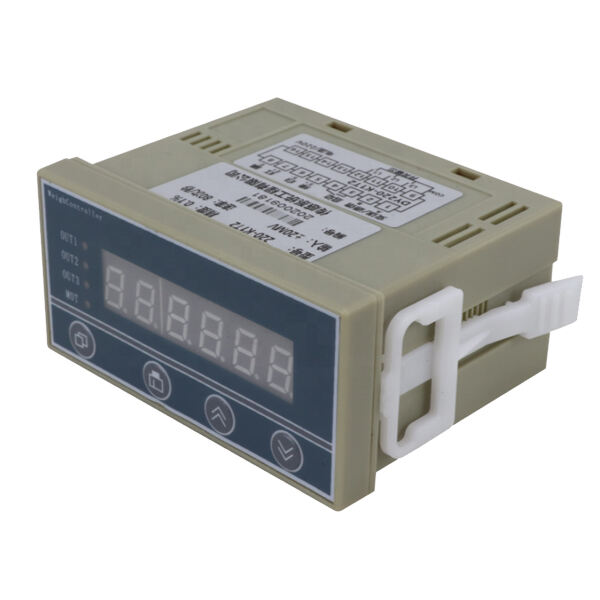Understanding the Impact of Load Cell Indicators on Measurement Accuracy
In the rapidly evolving world of industrial measurement and weighing technology, load cell indicators have emerged as crucial components for enhancing data precision. These sophisticated devices serve as the bridge between raw load cell signals and actionable measurement data, fundamentally transforming how industries approach weight measurement and process control. By converting complex electrical signals into readable measurements, load cell indicators have become indispensable tools across various sectors, from manufacturing to logistics.
The integration of load cell indicators into modern weighing systems represents a significant leap forward in measurement technology. These devices not only display weight readings but also process, filter, and analyze data in real-time, providing unprecedented levels of accuracy and reliability. As industries continue to demand higher precision and more detailed data analysis, understanding the capabilities and benefits of load cell indicators becomes increasingly important.

Core Components and Functionality of Load Cell Indicators
Signal Processing and Conversion Features
At the heart of every load cell indicator lies sophisticated signal processing technology. These systems employ advanced algorithms to convert analog signals from load cells into stable, accurate digital readings. The process involves filtering out electrical noise, compensating for temperature variations, and applying calibration factors to ensure consistent measurements under varying conditions.
Modern load cell indicators incorporate high-resolution analog-to-digital converters, typically offering resolutions up to 24 bits. This level of precision allows for extremely accurate weight measurements, with some systems capable of detecting changes as small as 0.01% of the full scale. The signal processing capabilities also include features like automatic zero tracking and digital filtering, which help maintain accuracy over extended periods.
Display and Interface Options
The visual interface of a load cell indicator plays a crucial role in data interpretation and system operation. Contemporary indicators feature high-contrast LCD or LED displays, offering excellent visibility in various lighting conditions. Many models include programmable display modes, allowing users to view weight data in different formats, including gross weight, net weight, and tare values.
Advanced load cell indicators often incorporate touchscreen interfaces, providing intuitive access to calibration settings, measurement parameters, and data logging functions. These user-friendly interfaces reduce training requirements and minimize the risk of operator error, ultimately contributing to improved measurement accuracy.

Advanced Features Enhancing Measurement Precision
Calibration and Configuration Capabilities
Proper calibration is essential for maintaining measurement accuracy, and modern load cell indicators excel in this aspect. They offer multiple calibration methods, including traditional span calibration, linearization points for non-linear applications, and digital calibration options. These features allow users to optimize system performance for specific applications and environmental conditions.
Configuration options extend beyond basic calibration to include parameters such as filter settings, update rates, and stability criteria. Advanced indicators allow users to fine-tune these settings to achieve the optimal balance between measurement speed and stability, ensuring reliable results in challenging industrial environments.
Data Management and Integration
Modern load cell indicators serve as comprehensive data management tools, offering features that go well beyond simple weight display. They incorporate data logging capabilities, allowing users to track measurement history, identify trends, and generate detailed reports. Many systems can store thousands of readings with corresponding timestamps, providing valuable information for quality control and process optimization.
Integration capabilities have become increasingly important in today's connected industrial environment. Advanced load cell indicators support various communication protocols, including RS-232, RS-485, Ethernet, and wireless options. This connectivity enables seamless integration with process control systems, data acquisition software, and enterprise management platforms.
Practical Applications and Industry Benefits
Manufacturing and Quality Control
In manufacturing environments, load cell indicators play a vital role in ensuring product consistency and quality control. They enable precise monitoring of raw material quantities, component weights, and finished product specifications. The ability to maintain accurate records and generate detailed reports helps manufacturers comply with quality standards and regulatory requirements.
Quality control applications benefit from advanced features such as check weighing capabilities, statistical analysis tools, and programmable setpoints. These functions allow manufacturers to identify and address variations in real-time, reducing waste and improving production efficiency.

Logistics and Material Handling
The logistics sector relies heavily on accurate weight measurement for inventory management, shipping calculations, and compliance with transportation regulations. Load cell indicators equipped with advanced data management features help streamline these operations by providing reliable weight data and automated documentation.
Material handling applications benefit from features such as motion detection, dynamic weighing capabilities, and multi-scale management. These capabilities enable efficient operation of vehicle scales, conveyor systems, and warehouse management systems while maintaining high levels of accuracy.
Future Trends and Technological Advancements
Smart Technology Integration
The future of load cell indicators lies in increased connectivity and intelligence. Emerging trends include the integration of artificial intelligence and machine learning capabilities, enabling predictive maintenance, automated calibration adjustments, and enhanced error detection. These advances will further improve measurement accuracy while reducing maintenance requirements.
Internet of Things (IoT) integration is becoming increasingly prevalent, allowing load cell indicators to participate in broader industrial automation networks. This connectivity enables real-time data sharing, remote monitoring, and advanced analytics capabilities that can optimize overall system performance.
Environmental Adaptability
Manufacturers are developing load cell indicators with enhanced environmental resistance and adaptation capabilities. These improvements include better temperature compensation, moisture protection, and electromagnetic interference resistance. Such advancements ensure reliable operation and consistent accuracy across a wider range of environmental conditions.
The focus on environmental adaptability extends to power management features, with new indicators incorporating energy-efficient components and alternative power options. These developments make it possible to maintain high precision even in remote or challenging locations.
Frequently Asked Questions
How often should a load cell indicator be calibrated?
The calibration frequency depends on several factors, including usage intensity, environmental conditions, and regulatory requirements. Generally, it's recommended to perform calibration at least annually, with more frequent calibrations in demanding applications or when required by industry standards. Regular verification checks should be conducted between full calibrations to ensure continued accuracy.
What factors can affect load cell indicator accuracy?
Several factors can impact accuracy, including temperature fluctuations, electromagnetic interference, mechanical vibration, and power supply stability. Professional installation, proper maintenance, and appropriate environmental protection measures are essential for maintaining optimal performance. Regular system checks and proper calibration help minimize these effects.
Can load cell indicators integrate with existing automation systems?
Yes, modern load cell indicators are designed with extensive integration capabilities. They support various industrial communication protocols and can be easily incorporated into existing PLC systems, SCADA networks, and enterprise management software. Many indicators also offer custom programming options to accommodate specific integration requirements.

